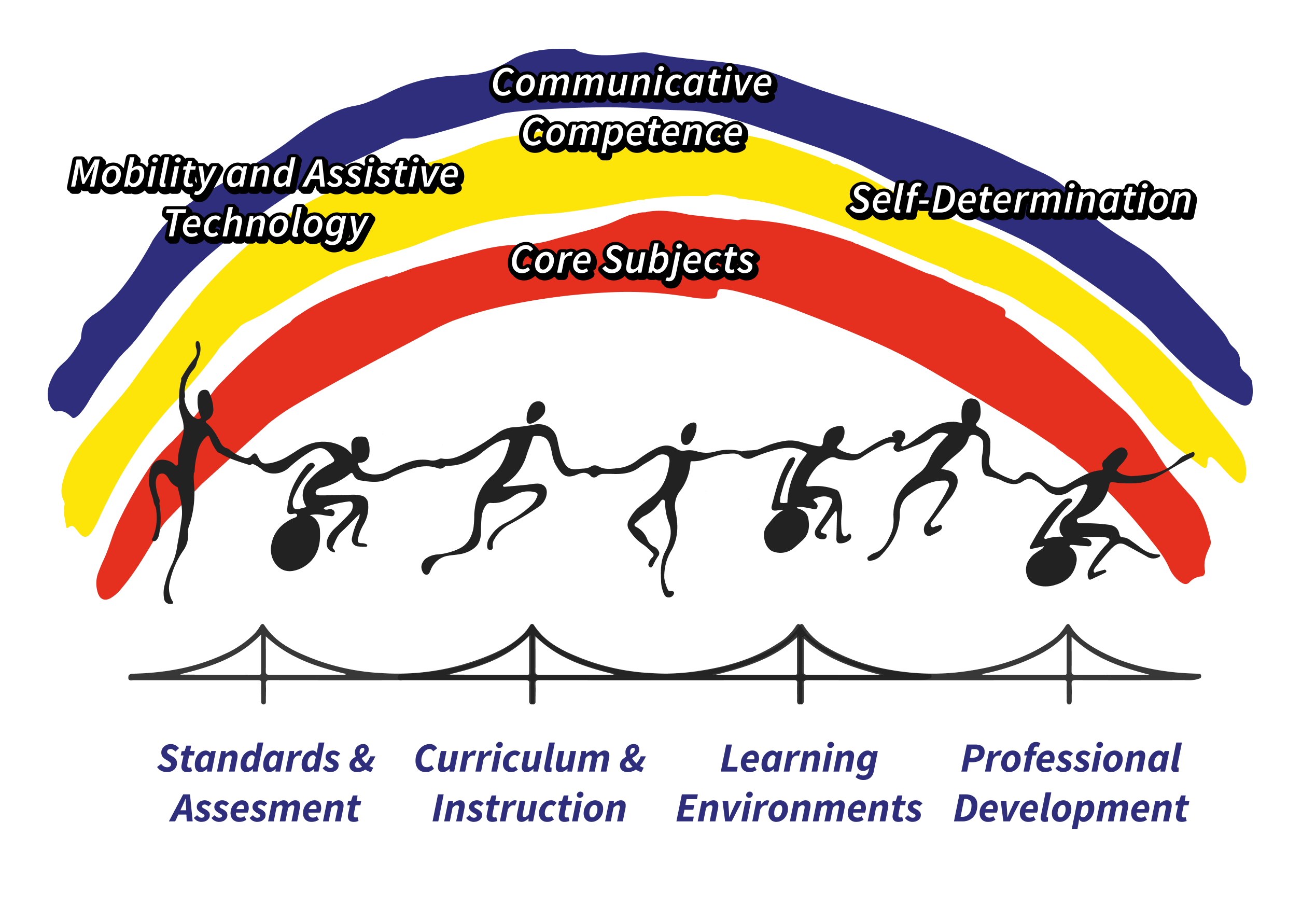Course of Study

Mobility and Assistive Technology
In order to meaningfully engage as active participants and access the full curriculum, Bridge School students learn to use a wide range of assistive technologies in the context of ongoing curricular activities. In this section, we describe the implementation of assistive technologies used by Bridge School students in our preschool, elementary, and middle school grades and beyond.
Continue to the Specialized Curricular Areas: Mobility & Assistive Technology section
Communicative Competence
Communicative Competence is considered an urgent, priority skill area for Bridge School students because proficiency with AAC/AT tools and communication strategies creates access, participation, motivation, and achievement in all curricular areas. AAC incorporates each student's full communication abilities and may include any existing speech, vocalizations, or gestures, as well as the use of communication boards and Voice Output Communication Aids (VOCA). In this section, we describe how we address the full range of communication modes and technologies as our students participate in ongoing instructional activities and social interactions.
Continue to the Specialized Curricular Areas: Communicative Competence section
Self-Determination
The Bridge School Self-Determination Curriculum provides students with the necessary tools and supports to become causal agents in their own lives through informed decision-making, thoughtful planning, and persistent action to achieve their goals. Becoming a self-determined individual involves learning about oneself, including one's strengths and interests. It involves using this knowledge to make decisions, and then communicating effectively to establish oneself as the primary agent in moving forward toward goal setting, attainment of those goals and greater independence. Bridge School students learn to express their individuality using multi-modal communication strategies and devices and learn to assert their independence with the necessary assistive technology devices and supports in place. Self-determination goals and objectives are embedded in all aspects of our curriculum and reinforced in every activity throughout the day.
Continue to the Specialized Curricular Areas: Self-Determination section
Core Subjects
At each grade level we offer all required Core Subject areas for Preschool and Kindergarten through Grade 5. These subject or content areas prescribe the "what" our students need to know and do as a result of their educational experiences. Implementing a standard curriculum with our students helps to ensure that, when they return to their home school district placement, that they will have had common experiences and educational content consistent with other students. "Curriculum embraces the broader meanings and purposes of education and represents the knowledge and skills identified as significant for students' success and participation in their daily lives." (Stump & Bigge, 2005).
Preschoolers thrive when they experience a curriculum that integrates all learning areas in ways that are motivating, predictable, meaningful and developmentally appropriate. Our preschoolers' daily schedule is carefully organized "activity by activity" vs. by subject areas. All required core content areas for preschoolers are systematically addressed across the day and include:
- Social-Emotional Development
- Language and Literacy
- English Language Development
- Mathematics
- Visual and Performing Arts
- Physical Development
- Health
- History-Social Science
- Science
Elementary Core Subject Areas
At the Elementary Grade level the Core Subject areas address California's Common Core Standards. Our weekly student schedule is organized by the core subject areas.
Preschoolers thrive when they experience a curriculum that integrates all learning areas in ways that are motivating, predictable, meaningful and developmentally appropriate. Our preschoolers' daily schedule is carefully organized "activity by activity" vs. by subject areas. All required core content areas for preschoolers are systematically addressed across the day and include:
- Social-Emotional Development
- Language and Literacy
- English Language Development
- Mathematics
- Visual and Performing Arts
- Physical Development
- Health
- History-Social Science
- Science
At the Elementary Grade level the Core Subject areas address California's Common Core Standards. Our weekly student schedule is organized by the core subject areas.
Standards and Assesment
State and federal standards as well as professional guidelines direct and inform the development of our curriculum and instruction. A collection of assessment tools are employed to document foundational learning progressions and competencies. These standards and assessment tools are detailed in this section.
Continue to the Instructional Foundations: Standards and Assessment
Curriculum and Instruction
The Bridge School's curriculum is a defined course of study that provides our educational teams with a blueprint for designing individualized instruction. By offering a well-defined curriculum, our educational teams can flexibility personalize each student's curriculum and instruction in ways that:
- Support and build upon current communication skills,
- Maximize grade-level academic and social participation,
- Prioritize and ensure desired educational outcomes, and
- Contribute to a positive quality of life for our students and their families.
Continue to the Instructional Foundations: Curriculum and Instruction
Learning Environments
There are numerous aspects to providing an accessible learning environment. In this section we include a detailed description of the school and how its location on a public school campus, our classrooms, garden, playground, and local community provides a range of accessible physical contexts for instruction and learning, as well as ongoing opportunities for inclusion, social interactions, field trips, and more.
Continue to the Instructional Foundations: Learning Environments
Professional Development
Professional development at The Bridge School is an ongoing, systematic approach to improving and expanding the knowledge and skill base of all staff members. Our collaborative team approach, our classroom staff roles, our training materials and activities are described in this section.
Continue to the Instructional Foundations: Professional Development

